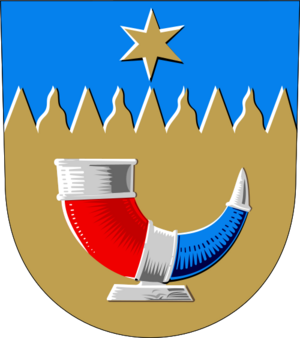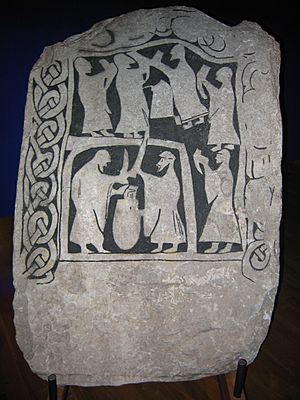Drinking horn facts for kids
A drinking horn is a special cup made from the horn of an animal like a cow or bull. People have used these horns as drinking cups for thousands of years. They were popular in ancient times, especially in places like the Balkans. They continued to be used for important events and ceremonies through the Middle Ages and into more recent times in parts of Europe, especially in Germanic countries and the Caucasus region.
Today, drinking horns are still very important in the country of Georgia. There, they are called kantsi and are used in special toasting rituals. Sometimes, drinking cups shaped like horns were also made from glass, wood, clay, or metal.
In ancient Greece, a drinking horn was simply called keras. There was also a different type of horn-shaped vessel called a rhyton. A rhyton had a small hole at its pointed end, so you would drink from that hole, not the wide opening.
Contents
Ancient Drinking Horns
Long ago, people in ancient Greece and among the Scythians used cups shaped like horns. These cups were made from clay or metal, but they also used real animal horns. An old Greek vase from around 480 BC shows the god Dionysus and a satyr (a mythical creature) each holding a drinking horn.
The Thracians and Scythians were groups of people known for drinking from horns. This was common during the Iron Age in Europe. A Greek writer named Xenophon wrote about the Thracian leader Seuthes, who used drinking horns in his feasts. Another writer, Diodorus, described a feast where the Getians (a Thracian tribe) used drinking vessels made from horn and wood.
The Scythian leaders also used special horn-shaped rhyta made entirely from valuable metals. One famous example is a gold and silver rhyton from the 5th century BC. It is shaped like a Pegasus (a winged horse) and was found in Adygea.
Archaeologists have found that Scythian drinking horns often came in two main types: a very curved one and a more slender, slightly curved one. The slender type was thought to be made from the horns of aurochs, which were large wild cattle. The oldest drinking horns found in Scythian burials date back to the 7th century BC. These show that the Scythians had contact with cultures from the East.
Scythian drinking horns were mostly found in the graves of warriors. This suggests that the horns were important for Scythian kings and their brave warriors. Some historians believe the drinking horn was a symbol of a ruler's power, given to him by a god. Other ideas suggest the horns were used in marriage ceremonies or when warriors made a blood-brother oath. These horns were clearly used for drinking wine.
Drinking horns also spread to Central Europe during the Iron Age. Some early Celtic (Hallstatt culture) horns have been found. A very large horn with gold bands was discovered in the Hochdorf Chieftain's Grave. It's harder to know how much ordinary animal horns were used for everyday drinking, because they usually decay and leave no trace. Only the metal parts of fancy ceremonial horns survive.
Julius Caesar wrote about the Gauls (an ancient Celtic people) using aurochs horns as drinking cups. He said these horns were very large and different from regular cattle horns. The Gauls would decorate the rim of these horns with silver and use them for big feasts.
Migration Period Horns
During the Migration Period, Germanic peoples started making glass drinking horns. They copied designs from the Romans. A beautiful glass horn from the 5th century was found in Bingerbrück, Germany, and is now in the British Museum.
The two Golden Horns of Gallehus from the early 5th century are famous examples. They were made from about 3 kilograms of gold and electrum (a gold and silver mix) each. Most people think they were drinking horns. Sadly, these horns were lost in 1802, and we only know what they looked like from old drawings.
Some important drinking horns from this time were made from the horns of the Aurochs. These huge wild cattle are now extinct. Their horns were carefully prepared and had silver rims. Parts of a famous aurochs horn were found at the Sutton Hoo burial site in England. The British Museum also has two Anglo-Saxon drinking horns from the 6th century. They are made from aurochs horns with silver-gilt decorations and were found in a royal burial at Taplow, England.
Many fancy drinking items have been found in the graves of women in Germanic societies. This shows that drinking horns were important for both men and women for a long time, from the Roman Iron Age all the way to the Viking Age.
Viking Age Horns
Drinking horns were also used in Scandinavia during the Viking Age. In the Prose Edda, a collection of Norse myths, the god Thor drank from a horn that secretly held all the seas. He drank so much that he scared the giant Útgarða-Loki! Drinking horns are also mentioned in the Old English poem Beowulf.
The poem Guðrúnarkviða II, written around 1000 AD, talks about carved horns:
|
Beowulf also describes serving mead (a type of honey wine) in carved horns.
Actual horn pieces from the Viking Age are rarely found because they decay. However, many metal decorations and fittings for horns have been discovered. This shows that drinking horns were very common. Most Viking Age horns were probably from domestic cattle and held less than half a liter. The much larger aurochs horns found at Sutton Hoo were unusual.
Medieval to Modern Horns
Drinking horns were special ceremonial cups for important people throughout the Middle Ages. They are mentioned in medieval stories, like the Arthurian tale of Caradoc and the romance of King Horn. The Bayeux Tapestry (from the 1070s) shows people feasting, and some are holding drinking horns.
Most Norwegian drinking horns from the Middle Ages have fancy metal decorations, but the horns themselves are usually plain. Some horns have carvings, but these appeared later and were simpler, like folk art.
Corpus Christi College at Cambridge University has a very large aurochs drinking horn. It is thought to be older than the college, which was founded in the 14th century. Students still drink from it at special college feasts.
The "Oldenburg horn" was made in 1474/75 for Christian I of Denmark. It is made of silver and gold, with rich decorations and the coats of arms of Burgundy and Denmark. This horn was kept in the Oldenburg family castle for 200 years before moving to Copenhagen. A legend says that a fairy woman gave it to Count Otto I of Oldenburg in 980.
Drinking horns continued to be used for ceremonies even in more recent times. A beautiful horn was made in 1547 for a guild in Amsterdam. It is now kept in the Rijksmuseum.
In 17th and 18th century Scotland, a special type of drinking horn developed. One aurochs horn is still kept at Dunvegan Castle on the Isle of Skye. It was only brought out for guests. To drink from it, a person had to twist their arms around its spines and drink from the right shoulder, expected to finish it all!
German horns from the Renaissance and Baroque periods were often decorated with lots of silver. A painting from 1653 by Willem Kalf called Still Life with Drinking Horn shows one of these beautiful horns.
Drinking Horns Today

Fancy drinking horns with gold, silver, and enamel decorations continued to be made as luxury items in the 19th and early 20th centuries in Austria and Germany.
In the 19th century, the idea of Vikings became popular again. This led to new drinking horns being made for German student groups to use in their special drinking rituals. A ceremonial drinking horn showing the story of the Mead of poetry was given to the Swedish poet Erik Gustaf Geijer by his students in 1817.
In Georgia, ram or goat drinking horns, called kantsi, are still an important part of their toasting culture. During a formal dinner called a supra, Georgians make toasts led by a toastmaster called a tamada. Toasts are made with wine or brandy.
In Swiss culture, a large drinking horn and a wreath of oak leaves are the traditional prize for the winning team of a Hornussen tournament, which is a traditional Swiss sport.
Today, people who follow the modern Norse religion called Asatru use drinking horns for their religious ceremonies and feasts.
|
See also
 In Spanish: Cuerno para beber para niños
In Spanish: Cuerno para beber para niños










